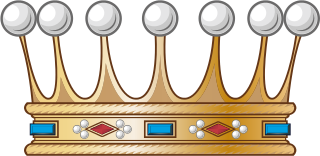
Baron is a rank of nobility or title of honour, often hereditary, in various European countries, either current or historical. The female equivalent is baroness. Typically, the title denotes an aristocrat who ranks higher than a lord or knight, but lower than a viscount or count. Often, barons hold their fief – their lands and income – directly from the monarch. Barons are less often the vassals of other nobles. In many kingdoms, they were entitled to wear a smaller form of a crown called a coronet.

The Council of the Realm, or simply The Council, was a cabinet of medieval origin, consisting of magnates which advised, and at times co-ruled with, the King of Sweden.

The Swedish nobility has historically been a legally and/or socially privileged class in Sweden, and part of the so-called frälse. The archaic term for nobility, frälse, also included the clergy, a classification defined by tax exemptions and representation in the diet. Today the nobility does not maintain its former legal privileges although family names, titles and coats of arms are still protected. The Swedish nobility consists of both "introduced" and "unintroduced" nobility, where the latter has not been formally "introduced" at the House of Nobility (Riddarhuset). The House of Nobility still maintains a fee for male members over the age of 18 for upkeep on pertinent buildings in Stockholm.

Freiherr, Freifrau and Freiin are designations used as titles of nobility in the German-speaking areas of the Holy Roman Empire and in its various successor states, including Austria, Prussia, Bavaria, Liechtenstein, Luxembourg, etc. Traditionally, it denotes the titled rank within the nobility above Ritter (knight) and Edler and below Graf. The title superseded the earlier medieval form, Edelherr.

Axel Evert Taube was a Swedish author, artist, composer and singer. He is widely regarded as one of Sweden's most respected musicians and the foremost troubadour of the Swedish ballad tradition in the 20th century.

David Makeléer sometimes written as David Macklier, was the Governor of Älvsborg County, Sweden. He served from 1693 to 1708.

The Finnish nobility was historically a privileged class in Finland, deriving from its period as part of Sweden and the Russian Empire. Noble families and their descendants are still a part of Finnish republican society, but except for the titles themselves, no longer retain any specific or granted privileges. A majority of Finnish nobles have traditionally been Swedish-speakers using their titles mostly in Swedish. The Finnish nobility today has some 6,000 male and female members.

The Creutz family is a Swedish noble family with the title friherre with its roots in Swedish-governed Finland. The family, both a branch of counts and a baronial branch, continues in Finland and Sweden.

The Fleming family or Flemming is a Finnish noble family with a medieval frälse origin.

The Kurki family or Kurck, also known as the family of Laukko, is a medievally-originated Finnish noble family that produced several historically prominent persons. It is documented in the late 14th century. The family is usually divided in several lineages as it continued through female succession.

The Carpelan family is a Finnish noble family from Middle Ages. Members of the family were awarded with the title of Baron on 15 October 1771 by Adolf Frederick of Sweden.
Hugh Hamilton, 1st Viscount Glenawly was a soldier in Swedish and English service. He was awarded the title of friherre for his service to Sweden.

The Essen family or von Essen is the name of a Baltic German noble family which later became part of the Swedish and Russian nobility.

Baron Fredrik von Essen was a Swedish politician, friherre, Marshal of the Realm and lord of Kavlås Castle.

The House of Platen is a feudal noble family originally from Pomerania. The branch of Platen-Hallermund was a mediatized one and as such was part of the small circle of families that belonged to the High nobility in Germany.
Gyldenär, is the surname of an extinct Swedish noble family, enrolled in Riddarhuset [ "House of Nobility" ] with the number of 388.

The Koskullfamily, also written as Koschkull, is a wealthy aristocratic family of Livonian and German origin, famous for their extensive lands and manors. The family is descended from the first King of Livonia and officially established in Livonia as Koskele in 1302. The family spread to Estonia, Courland and Poland in the 15th century, Sweden and Finland in the 17th century, and Prussia and Russia in the 18th century. Several branches of the family still exist today. The Koskulls are believed to be related to the von der Pahlen family.

The Toll family was a Baltic German noble family of possible Hollandish origin. According to legend, the family's name originated from a castle near Leiden. The family held Swedish and Russian baronial and comital titles, Austrian baronial titles, Prussian, Oldenburgish, Finnish untitled noble status and also possibly belonged to Dutch nobility.

The Wachtmeister family is a Swedish noble family from Livonia, who immigrated to Sweden in the 16th century. The name Wachtmeister is German for 'sergeant'.

The Tersmeden family, originally tor Smede, is a noble Swedish family originally from Stade that rose to prominence in the 15th-century with Thomas tor Smede, founder of one of the most prominent trading companies in northern Germany. The family was elevated to noble rank in the Kingdom of Sweden in 1751, and got introduced at the House of Nobility in 1752. The Tersmeden family consists of several branches of different noble ranks.


















